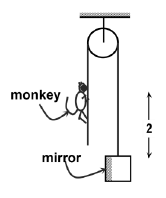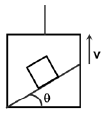JEE Advanced (Single Correct Type): Laws of Motion | Chapter-wise Tests for JEE Main & Advanced PDF Download
Q.1. Two blocks A and B of same mass are connected through a string and arranged as shown in figure. When the system is released from rest and there is no friction, then
 (a) Acceleration of A is g
(a) Acceleration of A is g
(b) acceleration of A is g/2
(c) Tension in the string is zero
(d) tension in the string is mg/4
Correct Answer is Option (d)
Mg - T = ma . . . .(i) T + mg sin q = ma . . . . (ii)
which gives a =
Tension in the string, T = mg - ma = mg /2 (1 - sin θ) = mg/4.
Q.2. A block of mass 0.1 kg is held against a wall by applying a horizontal force of 5 N on the block. If the coefficient of friction between the block and the wall is 0.5, the magnitude of the frictional force acting on the block is
(a) 2.5 N
(b) 0.98 N
(c) 4.9 N
(d) 0.49 N
Correct Answer is Option (b)
3. fmax = μR = 0.5 x 5 = 2.5 N
But actually f = mg = 0.1 x 9.8 = 0.98 N
Q.3. A 7 kg object is subjected to two forces in newton  and
and  The magnitude of resulting acceleration, in m/s2, will be approximately
The magnitude of resulting acceleration, in m/s2, will be approximately
(a) 5
(b) 4
(c) 3
(d) 2
Correct Answer is Option (a)
Q.4. Three equal weights A, B and C of mass 2 kg each are hanging on a string passing over a fixed frictionless pulley as shown in the figure. The tension in the string connecting weights B and C is
 (a) zero
(a) zero
(b) 13.33 N
(c) 3.3 N
(d) 19.6 N
Correct Answer is Option (b)
T - 2g = 2a, 4g - T = 4a ⇒ 2g = 6a or a = g/3
∴ 2g - T' = 2(g/3) ⇒ T' = 2g - 2g/3 = 4g/3
Q.5. If the external force F is applied at an angle θ with the horizontal as shown in figure, the value of F for which friction force between the block of mass m and the wall is zero, is (a) mg
(a) mg
(b) mg/sin θ
(c) mg/cos θ
(d) mg/tan θ
Correct Answer is Option (b)
F sin q = mg Þ F = mg/sin q
Q.6. In the adjacent figure, the monkey has a mass twice that of the block which has a plane mirror fixed on the monkey’s side (as shown). Initially, the system is at rest and the vertical separation between the monkey and the mirror is 2 m. The speed of the monkey when he looks himself in the mirror is
 (a)
(a) 
(b) 
(c) 
(d) √g/3
Correct Answer is Option (a)
Acceleration of the system = g/3
Now, when the monkey looks his image he would fall by 1 m and the mirror would rise by 1m.
∴ v2 = u2 + 2ag
⇒ v2 = 0 + 2 x g/3 x 1 ⇒ v =
Q.7. If force of 10/√3 N is applied horizontally on a block of mass 1 kg as shown in the figure, the frictional force acting on the block is
(a) zero
(b) 10/√3 N
(c) 20/√3 N
(d) 5 N
Correct Answer is Option (a)
mg sin 30°- FH cos 30° = 0
∴ Force of friction = 0
Q.8. The friction force acting between surfaces in contact in the adjoining figure is
 best represented by
best represented by
(a) 
(b) 
(c) 
(d) 
Correct Answer is Option (a)
Q.9. An accelerated system with a vertical wall has co-efficient of friction μ. A block M of mass 1 kg just remains in equilibrium with the vertical wall, when the system has an acceleration of 20 m/s2. Then, the value of μ is (a) 0.10
(a) 0.10
(b) 0.25
(c) 0.50
(d) 1
Correct Answer is Option (c)
μma = mg ⇒ μ = g/a = 10/20 = 0.5
Q.10. The linear momentum P of a particle varies with time as follows: P = a + bt2, where a and b are constants. The net force acting on the particle is
(a) proportional to t
(b) proportional to t2
(c) zero
(d) constant
Correct Answer is Option (a)
F = dP/dt = 2bt ⇒ F ∝ t
Q.11. The triangular wedge shown in the figure is pulled towards left with an acceleration of 1.5g. What is the acceleration of m1? (a) g downwards
(a) g downwards
(b) 1.5g towards right
(c) 1.5g in vertically downwards direction
(d) None of the above.
Correct Answer is Option (a)
In the frame of the inclined plane, a⊥ to the inclined plane =
Thus, contact will be lost. Hence, the block m1 will undergo free fall.
Q.12. If the system in the adjacent figure is released from rest, then (i) acceleration of 2 kg block = acceleration of 3 kg block = 0.
(i) acceleration of 2 kg block = acceleration of 3 kg block = 0.
(ii) frictional force between 2 kg block and incline = 5 N
(iii) acceleration of 2 kg block =0.5 m/s2, acceleration of 3 kg block = 0.25 m/s2
(iv) frictional force between 2 kg block and incline = 10 N.
Now, choose the correct option.
(a) (i) and (ii) are correct.
(b) (ii) and (iii) are correct.
(c) (iii) and (iv) are correct.
(d) (iii) and (iv) are correct.
Correct Answer is Option (a)
f = μs mg cos 30° = 15 N
mg sin θ = 10 N
At rest, tension = 15 N
So, system will not move.
Acceleration of 2 kg block = acceleration of 3 kg block = 0.
Frictional force = 5 N
Q.13. A small block of mass 2 kg is kept on a bigger block of mass M. The coefficient of friction between blocks M and m is 0.1. The bigger block M is given a constant acceleration 2 m/s2. The acceleration of 2 kg block is
(a) 1 m/s2 towards right
(b) 1 m/s2 towards left
(c) 2 m/s2 towards right
(d) 2 m/s2 towards left
Correct Answer is Option (a)
With respect to bigger block:
FP – f = ma
4 – 2 = 2a
a = 1 m/s2
With respect to ground: Acceleration = 2 - 1 =1 m/s2 towards right.
Q.14. A block rests on an inclined plane. The force of friction acting on the block is (1/n) times. The force required to move the block up the inclined plane with a uniform velocity (n>1). If μ be the coefficient of friction, then the inclination of the plane with the horizontal is
(a) tan-1[(n-1)/μ]
(b) tan-1[μ(n-1)]
(c) tan-1[μ/(n-1)]
(d) tan-1(μ)
Correct Answer is Option (c)
mg sin θ = 1/n (mg sin θ + μmg cos θ)
⇒ mg sin θ(n -1) = μmg cos θ
⇒ tan θ = μ/(n - 1)
Q.15. Two blocks of masses 2 kg and 1 kg are in contact with each other on a frictionless table. When a horizontal force of 3.0 N is applied to the block of mass 2 kg, the value of the force of contact between the two blocks is
(a) 4 N
(b) 3 N
(c) 2 N
(d) 1 N
Correct Answer is Option (d)
The contact force F' accelerates the body of mass m1 = 1 kg with an acceleration
⇒ F = m1a = 1 x 1 = 1 N.
Q.16. A block of metal weighing 2 kg is resting on a frictionless plane. It is struck by a jet releasing water at a rate of 1 kg/sec and at a speed of 5 m/sec. The initial acceleration of the block will be
(a) 2.5 m/s2
(b) 5.0 m/s2
(c) 10 m/s2
(d) none of these
Correct Answer is Option (a)

Q.17. A block A is able to slide on the frictionless incline of angle q and length l, kept inside an elevator going up with uniform velocity v. Find the time taken by the block to slide down the length of the incline if released from rest. What would be the time taken if the elevator is accelerated at ‘a’ ms-2. (a)
(a) 
(b) 
(c) 
(d) none of these
Correct Answer is Option (a)
Q.18. The system shown in the figure is in equilibrium. Masses m1 & m2 are 2 kg and 8 kg respectively. Spring constants k1 & k2 are 50 N/m and 70 N/m respectively. If the compression in second spring is 0.5 m. What is the compression in first spring? (Both springs have the same natural length) (a) 1.3 m
(a) 1.3 m
(b) –0.5 m
(c) 0.5 m
(d) 0.9 m
Correct Answer is Option (b)
As the springs are fixed to the horizontal and have the same natural length, hence if one spring is compressed, the other must be expanded. Hence, the compression will be negative.
F.B.D of m2 T + F2 = 80 N and F2 = 70 x 0.5 = 35 N
∴ T = 80 – 35 = 45 N
F.B.D of m1T + F1 + mgor 45 = F1 + 20
or F1 = 25 N∴ x1 = 25/k1 = 25/50 = 0.5 m
∴ Compression in first spring = –0.5 m
Q.19. Two masses M1 and M2 are attached to the ends of a string which passes over the pulley attached to the top of a double inclined plane. The angles of inclination of the inclined planes are α and β. Take g = 10 m/s2. If M1 = M2 and α = β, what is the acceleration of the system?
(a) zero
(b) 2.5 m/s2
(c) 5 m/s2
(d) 10 m/s2
Correct Answer is Option (a)
The net force F = M1g sinα- M2 g sin β = (M1 sin α- M2 sin β)g
When M1 = M2 and α1 = α2 , the net force is zero.
⇒ The acceleration of the system = 0
Q.20. In the arrangement shown in the figure, the elevator is going up with an acceleration of g/10. If the pulley and the string are light and the pulley is smooth, the tension in the string AB is (a) 44/15 mg
(a) 44/15 mg
(b) 88/15
(c) 22/15 mg
(d) 44/150 mg
Correct Answer is Option (a)
T1 = 2T2 ...(1)
For mass 2mT2 - 11/5 mg = -2ma ...(2)
For mass m,
T2 - 11/10 mg = ma ...(3)Solving (2) and (3)
T2 = 22/15 mg
∴ Tension in part AB,
|
481 docs|964 tests
|








































